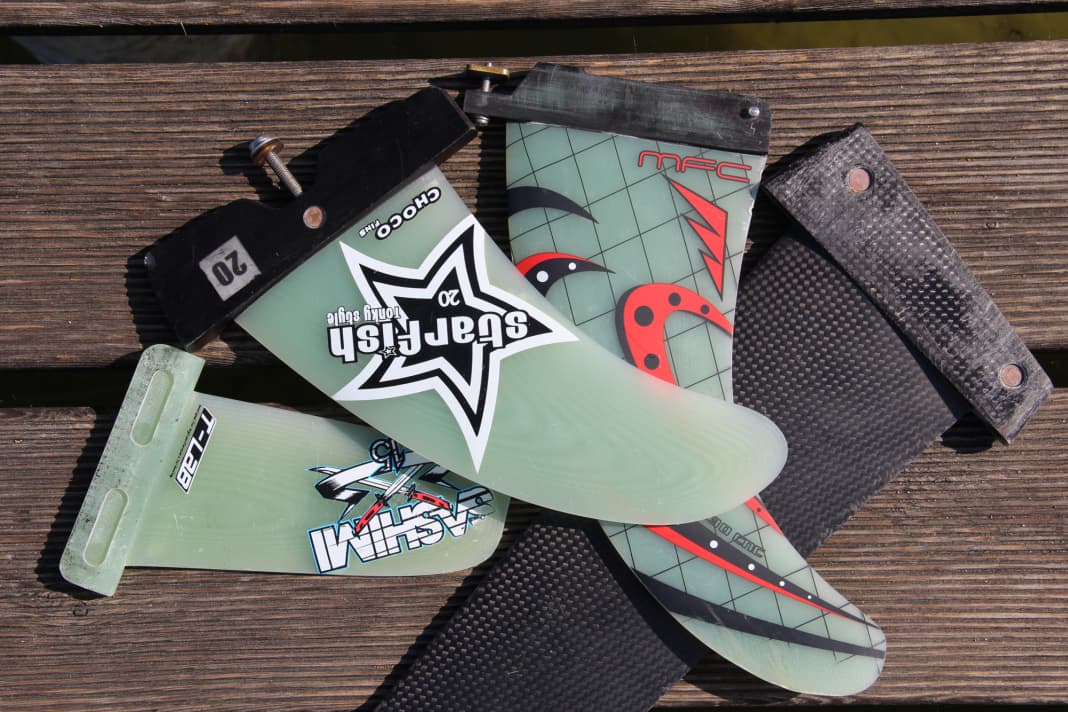





Very few surfers will choose their board based on the fin box alone. However, it can sometimes be worth taking a look at the alternatives in order to be able to use existing fins in a new board - such as weed fins or your favourite fin from the previous board.
We provide an overview of the fin systems on the market:
Most boards come with a fin as standard, which means you can't go far wrong. Only purebred slalom boards usually come without a fin, as professionals and regatta riders usually choose them according to personal preference and performance. A good slalom fin is also very expensive. Other board groups usually come with decent fins - of the better-known brands, only Naish and We One currently supply their boards "bottomless", so suitable fins have to be purchased separately.
If you want to increase the performance of your equipment or change the riding characteristics of your board, you can achieve a lot with a different fin. You can find advice on this here:
The correct fin position
Some systems, such as US-Box and Starbox, make it possible to move the fin on wave boards along the longitudinal axis of the board. Whether twinser, thruster or quad - the fin position has a noticeable effect on the board's riding characteristics. The following applies: if you move the fins backwards, you lose turning potential, but improve planing and acceleration somewhat, and the tail also takes on a little more pressure - a tip for light winds in combination with large sail sizes, for example. Conversely, pushing the fins forwards leads to freer, more agile turning behaviour - ideal for tight hooks and sliding manoeuvres such as Takas, but at the expense of planing characteristics.
Powerbox
The perennial favourite among fin boxes: simple, practical and versatile. From freemove to freerace boards, the Powerbox has been used in all board classes and sizes for many decades. The selection on the fin market is correspondingly large, for example for weed fins.
Function/structure:
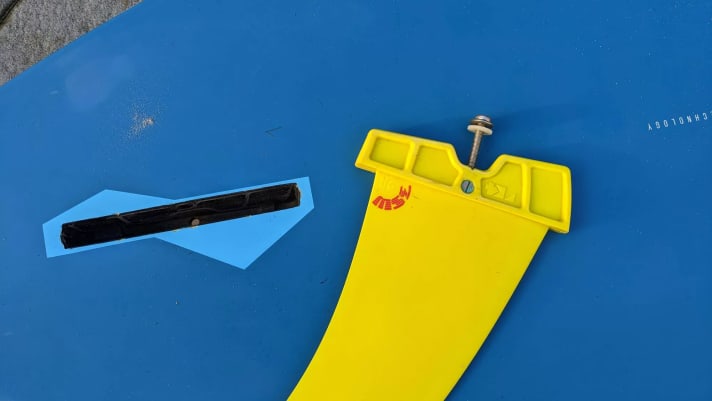
The fin head for the Powerbox is conical in shape, which means that all sides run towards each other. This has the advantage that the fin sits firmly in the box even if it does not fit perfectly. The screw is screwed through the board from above, the length is uniform and also makes replacement easier. There should be one plastic washer and one metal washer. However, the Powerbox is not suitable for very long fins (from approx. 50 cm), as the conical head can be levered out of the box by the transverse forces - in this case a washer is required. Tuttlebox in demand. Foils are also available with a power box, which are then stabilised by a plate on the base
- + large selection, versatile
- + easy handling
- + fins almost always fit
- - not suitable for long fins
US box
Oldie, but Goldie: The US box has been on the market since the early days of windsurfing. Today, it is mainly used for waveboards (for the centre fin), as the fin can be moved lengthways and enables infinitely variable trimming. It also fits into thin waveboard tails thanks to its low height. However, the installation with small plates and a small screw is not for cold fingers and people who like to lose small parts.
Function/structure
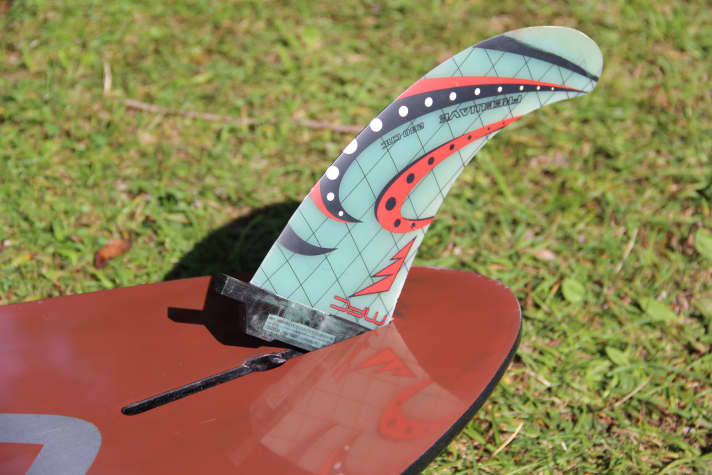
The base with parallel surfaces has a transverse splint at the rear, which is inserted into a recess in the box. A small plate is also inserted, into the thread of which the screw on the front edge is screwed.
- + adjustable
- + low overall height
- - fiddly installation
- - Small parts that can get lost
- - only suitable for smaller fins
- - Weak point at the hole for the screw, can easily break here
Slotbox
The little sister of the US box. Thruster boards usually have this version of the side fins, while quads are often fully equipped with slot boxes. They are significantly lighter than US boxes, which is a very relevant factor for multifin boards. Slot boxes come from surfing and are only suitable for very small fins. Depending on the length of the box, these can also be moved lengthways to a small extent.
Function/structure:
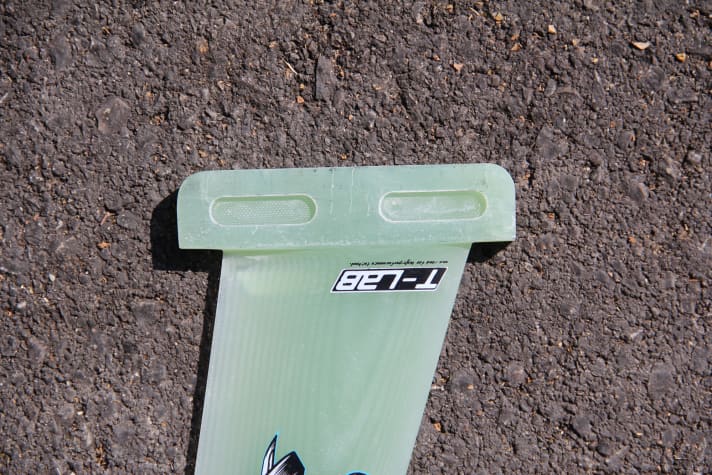
The fins have small recesses on the sides of the head. The two screws per fin are screwed into the box at an angle on the underside of the board and then pack into these recesses.
- + Easy handling, screws can remain in the board
- + partially adjustable
- + small and light
- - Threads in the board can become damaged over time
- - for small fins only
- - Grooves can be damaged at certain points and "wear out" on ground contact
Starbox
Starboard's own development for the sidefins on waveboards, now also used by Severne. A mixture of slot box and US box, including their advantages and disadvantages. The adjustment range is larger, handling is somewhat simpler. Normal slotbox fins can be easily adapted to the Starbox by sawing a corresponding notch at the front.
Function/structure:
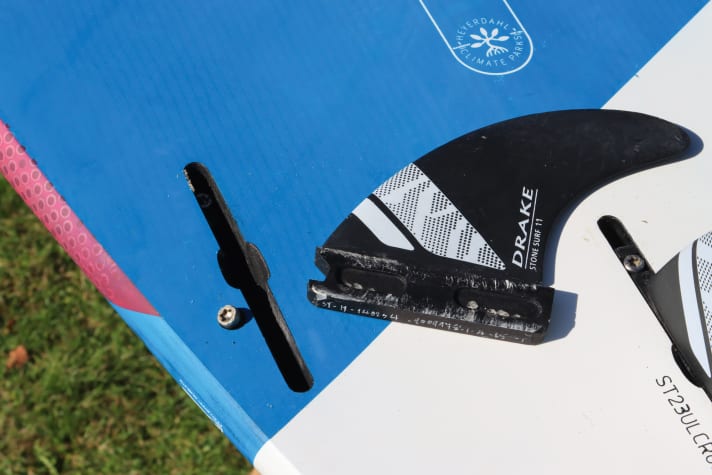
As with the US box, a small plate is inserted into the box, but then initially screwed into place without the fin. This can remain in the box. The fin is then hooked onto the plate with the notch and fixed at the back with a second screw at an angle from the side, as with the slot box.
- + adjustable
- + all slot box fins can be customised
- + Tile can remain on the board
- + small and light
- + more stable than the slot box at base contact
- - Many small parts
- - Rear thread can noodle out
Tuttlebox
Where the Powerbox When long slalom fins reach their limits, the time has come for the tuttle box. It is mainly used for purebred slalom boards and in the foil sector. A little grinding work is sometimes necessary for a firm fit.
Function/structure
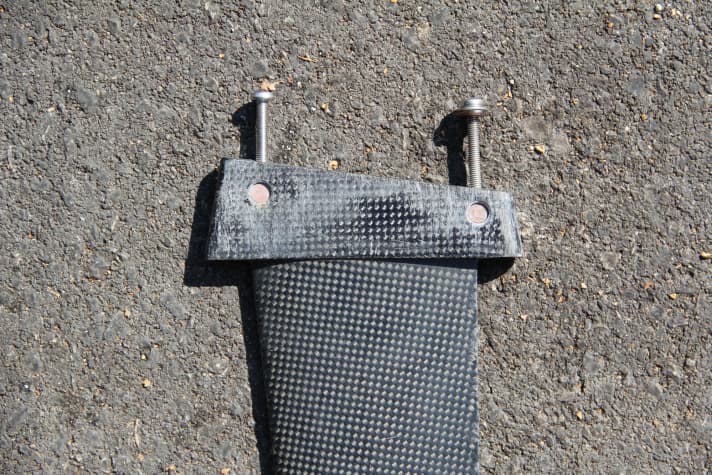
Similar to the Powerbox, a Tuttlebox fin is screwed on from above, but here two screws are used. The head is slightly larger than the Powerbox (and therefore requires a fat tail), the side surfaces are parallel and therefore less sensitive to high lateral forces. The front and rear sides of the head converge, so the head tapers towards the top.
- + also suitable for long fins and foils
- - Handling somewhat more complex
Deep Tuttlebox
Similar in principle to a tuttle box, but with an even higher head. First used for extremely long Formula fins, now widely used for sporty foils in particular. Here too, the box and head must fit well.
Function/structure

Here too, two screws are screwed through the tail from above. As the lower part of the head is practically identical to the normal tuttle box, fins of the smaller version can also be fitted using the appropriate screws.
- + suitable for long fins and foils
- + fins can be used for normal Tuttlebox, adapters available
- - Relatively heavy
Mini Tuttlebox
Variant of the tuttle box for small side fins on waveboards.
Function/structure
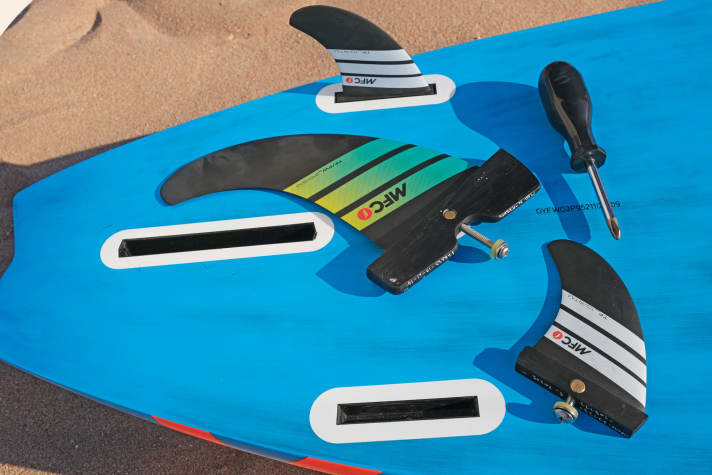
The head of the fin is shaped similarly to a slot box, but without the side notches. The fin is screwed through the board from above using a screw
- + easy handling
- + Adapter for other small systems (e.g. slot box) available
- - Tail needs to be a little thicker
- - Little choice on the accessories market
- - not adjustable
Double US box
In the foil sector, two parallel US boxes to see:
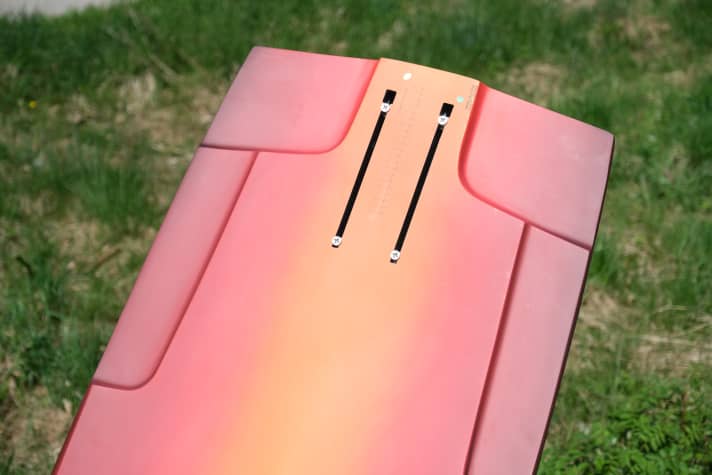
Two threaded blocks are inserted into the rails on each side. In some variants, these can be fixed in the rail with a small Allen screw and can then remain in the board. The foil is then attached to the threads with a base plate.
- + Low height, also suitable for thin boards
- + Good force distribution across the plate
- - fiddly, many small parts
- - only usable for foiling
FCS box
system from surfing, has been established there since the 1990s. Whereas previously the fins were often permanently laminated to the surfboard, the FCS (Fin Control System) allows them to be exchanged or removed for transport. It can only be used for small fins without a lot of side pressure, which is why it is not used in windsurfing, but only on wave SUPs with a multifin setup.
Function/structure
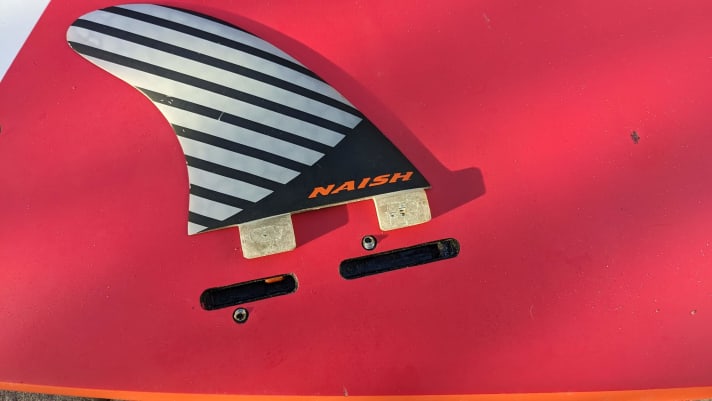
The basic principle is identical to the slot box: The fins are inserted into the boxes and fixed in place with angled screws that engage in a groove in the fin head. With FCS, however, everything is one size smaller and the head is divided into two "tabs". Since 2013, there has also been FCS-II, in which the fins are no longer screwed in, but only clicked in. The systems are upwardly compatible, which means that conventional screw fins also fit into the click system, but newer click fins do not fit into the normal boxes.
- + small and light
- - Can only be used for very small fins
Older fin systems
Trimbox
In the 80s and 90s, Fanatic in particular used its own solution with the Trimbox, which was also used by Bic in some cases. The principle was similar to the Powerbox, but it could be adjusted lengthways via several threads in the fin head. It died out when Fanatic was taken over by Mistral.
Conicbox
Also extinct, formerly a speciality of Tiga. As the name suggests, the head was conical, just like the Powerbox. At the front, the fin was hooked onto a cross bolt with a notch and then screwed to the rear end from above. Even during its lifetime, it was an exotic model with a difficult supply of spare parts, but Trimbox fins could be made to fit more or less perfectly.

